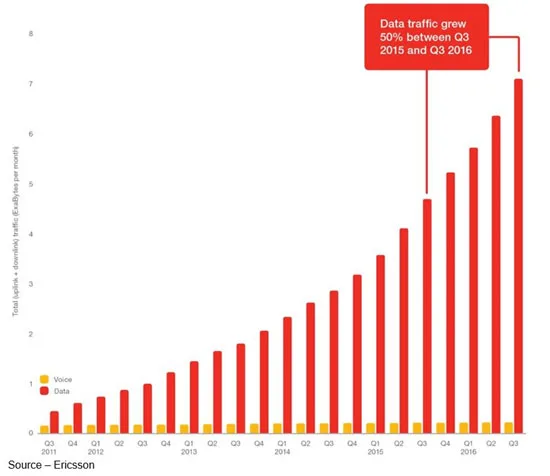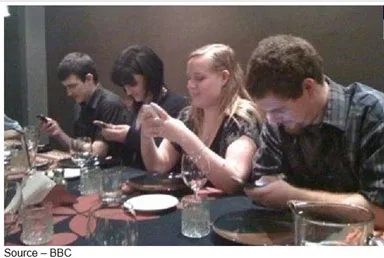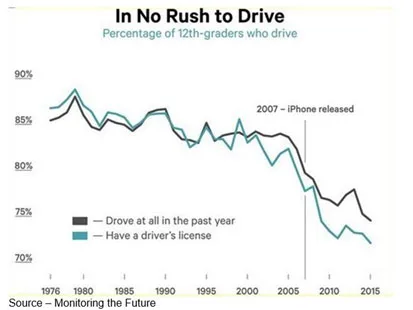Technology that Brings Us Together Also Drives Us Apart

First, it was Al Gore inventing the Internet. Then, Tim Berners-Lee came up with the Web.
Finally, we were able to do things on a global basis.
Motorola’s Martin Cooper showed off the mobile phone and phone booths started to disappear.
Then, Jobs introduced the iPhone and folks mashed all of the communications tools together.
Suddenly, normal human contact changed – seeing people, talking to them, arguing with them, fighting with them, celebrating with them, being with them.
You know, normal stuff.
I just hollered into my kid’s room and told him to go out and be with people.
His response was he was too busy with friends:
- Chatting on Instagram
- Video mashing on Facebook
- Texting
- Posting, marking up selfies
- Playing VR Eve:Valkyrie with friends halfway around the globe

To him, and a great many Gen Zers, they’re too busy with folks to be with folks.
They’ve been device-connected since birth.
They’re able to reach out and connect with someone quickly, without interrupting either one of them.
According to a recent Monitoring the Future report, kids actually spend more time at home under the same roof with their parents. But they really aren’t any closer to them, they’re just … there.
You know, the usual response… “okay, right, fine, whatever.”
Instantly, they’re back on the phone browsing, texting and posting.
The report noted that teens are getting physically together with peers far less than in the past, dropping 40 percent between 2000-2015.
Recently it’s gotten worse.

Whether it’s on social media or texting, the data connection works much better for Gen Zers — and increasingly, for everyone else — than the old-fashioned phone call.
Like nearly all of today’s technology, the introduction of the smartphone has it’s good and bad points.

According to an NYU report, people average three hours a day on their phones.
In the pre-smartphone era, that number was just 18 minutes.
The good news with all this data communications is that the phone-to-the-ear cancer scare isn’t much of an issue anymore.
Even when folks do break down and place a call, they usually put it on speaker so they can share the conversation with others:
- In the elevator
- On the subway
- In the airport
However, we can’t blame the smartphone, the technology tools, the web or all the apps people stuff on the phone to stay in touch.
They’re just hooked on it … all of it.
A while back, Arianna Huffington, founder of Huffington Post, was hawking her new book on The Colbert Report and said people checked their phones way too often … even during very intimate engagements.

Seriously folks, focus!
It’s so bad that some European cities have embedded traffic signals in the sidewalk/crosswalk.
Hawaii simply banned mobile device usage when crossing the street.
Fortunately (or unfortunately), it won’t be a problem for me because I find it difficult to walk and chew gum at the same time … let alone text or dial a call.
The controversial smartphone zombie law (and fines) probably won’t stop folks. After all, jaywalking laws don’t stop people from jaywalking.
Laws saying you can’t call, text, selfie or email while driving certainly haven’t reduced the number of auto accidents/fatalities.
But then, a fine (or two) could be the least of your worries.
Honestly, the constant barrage of stuff coming to a person’s device(s) doesn’t make folks less alone.

Whatever stuff that’s going on in your virtual world is probably less important than the individual or people right in front of you or next to you.
Sure, the Web was around for Millennials; but it wasn’t always in your face, in your hand, next to you in bed.
But Gen Zers are growing up with their smartphones; their Instagram, Twitter, Facebook and whatever accounts.
Interesting–the iPhone was introduced in 2007, the iPad in 2010; and a recent U.S. survey of 5,000 American teens showed that three out of four kids owned an iPhone; the others, something else.
But it isn’t the phone that’s the issue, it’s the stuff you put on it, the stuff you use constantly. Yes, all those really cool, really fun, really connected apps.

It’s what Tristin Harris, former product manager at Google, recently called brain hacking or social media addiction during an interview on 60 Minutes.
Talking with Anderson Cooper, he said app programmers work very hard to keep the user attached to his/her phone; which is probably why the average American spends five hours a day glued to the screen.
And it works well for Gen Zers who were born with the phone in their hands. According to the study, they spend an unbelievable nine hours a day on social platforms.
Of course, the teen (or Millennial) doesn’t really have to be with people to be with people because they’re connected through the web.
That’s probably why they tend to spend more time at home – it certainly isn’t to “be” with the family – it’s just that they don’t have to leave to be with friends.
An indication of the changes taking place was reported by the University of Michigan which found today’s teens don’t have the same rush to get behind the wheel as earlier generations.

That used to be a rite of passage when you finally got that all-important driver’s license.
With that lowly little card, kids could get away from their parents and enjoy a world of their own.
Suddenly, they could drive away to drink, smoke, make out in the backseat, do stuff.
When the folks asked, “When will you be home?” the response was “When do I have to be home?”
Yep, it was still their house, their rules.
Of course, pushing back on the shackles (opportunities) of adulthood isn’t new.
Gen Xers started careers and families later than boomers and boomers held off longer than the silent generation.
They seem to be stretching adolescence beyond its earlier limits.
They become adults earlier but hang onto their 18-year-old type of life longer. Eighteen-year-olds act like 15-year-olds and 15-year-olds are more like 13-year-olds.
If we keep on this path, childhood could be an integral part of work. You know; slides, swings, sandboxes, trampolines, Legos, naptime, all that kid stuff.
None of this really bothered me too much because after all – kids outgrow stuff, right?
But then I read two reports on population studies in Asia.
Maybe – just maybe – the always with you, always-on device really could cause irreversible damage to humans.
Whether Japanese, Chinese or South Korean; Asian youth took to the mobile phone faster than those in the Americas or Europe. Even with the flip phones, they had apps and SMS/texting down cold and were using it years ahead of the rest of us.
In these cultures, where working long hours is the norm, there was also a social pressure to do things as a collective group.
After work, the group went out to drink together, eat together, be together.
But in recent years, there has been a shift. Gen Zers and millennials run their own errands during lunch, rather than eating together.
They go out in the evening and drink/eat alone.
Increasingly, they also don’t mind traveling alone.
O.K., that’s all fine but there’s a specter on the horizon that could spread around the globe and become really, really popular … weddings alone.

It’s all part of a new-found, individualistic lifestyle called YOLO (You Only Live Once).
Psychologists have spent the last few years studying and analyzing the YOLO “movement” but companies aren’t questioning it.
They’re just learning how to capitalize on it!
They have YOLO credit cards; YOLO discounts at stores, theatres, Starbucks, everywhere; YOLO vacation planning; spontaneous YOLO treasure hunts; YOLO sport trips and more.
They’re eliminating the stigma of going to an establishment and drinking or eating alone because you’re alone together.
Be single, be proud, be yourself … YOLO!
Women have been some of the first to adopt the YOLO life, declining or delaying marriage because they didn’t want anything to interfere with their careers as they focused in punching through the glass ceiling.
American, British, French, Brazilian or Saudi women may be cheering Asian women on; but remember, these are cultures that emphasize the family and an unbroken lineage.
The younger generation though is pushing back for more me time.
Okay, it’s not really me time because the smartphone is always close, always in use.
So, I guess it’s me/YOLO/alone together smartphone time.
Now that’s okay, but you have to remember it was just “a few years” back that China abandon their one child and it better be a boy rule so today:
- There’s a huge surplus of guys looking for a partner
- Emancipated women who are focused on making their mark in the world
Talk about the perfect storm.

People in these areas are moving to the city, women are delaying marriage choosing to focus on their careers rather than pregnancy and seemingly find that the smartphone is the fast, easy way to connect/stay in touch with friends and family.
In Korea, single-person households are most common, making up 27 percent in 2015.
The decline and delay of marriage in China, Japan and Korea is part of a global trend. In Korea, less than half the women surveyed felt that marriage is a must.
Not that I’m looking (happily married); but I agree with the Chinese government that urged women to “lower unrealistic standards during their search for a partner.”
Probably watching too many video heroes!
I’m not saying it’s all the fault of our alone together technology but I do agree with Chuck Noland that we need to put down our devices and look around because, “The most beautiful thing in the world is, of course, the world itself.”
# # #